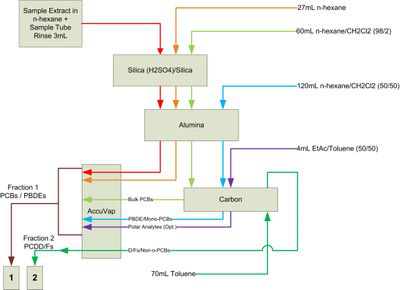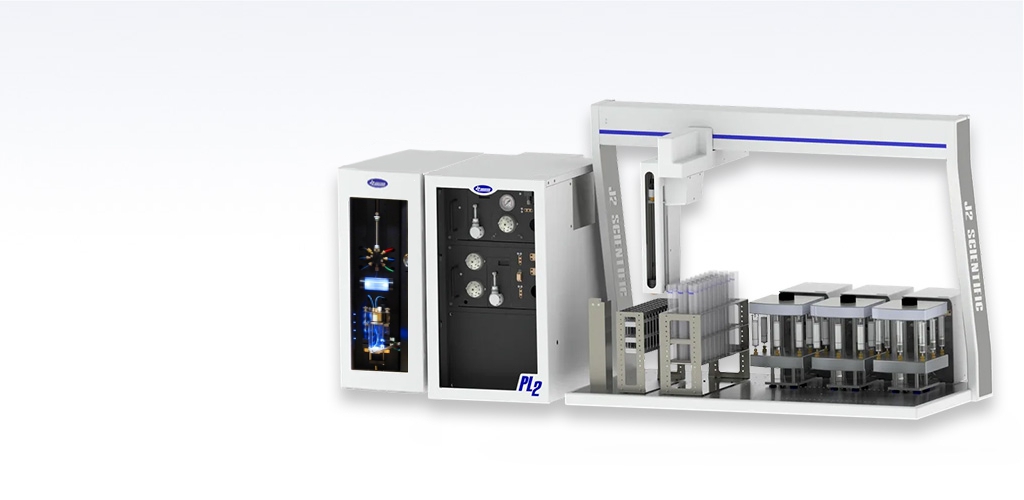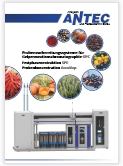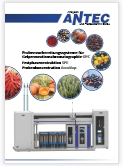The PrepLinc Traditional Dioxin Cleanup System automates the multi-step Dioxin Cleanup procedure. PrepLinc SPEi Column modules allow flow from column to column. Elutions can flow through, bypass or reverse elute through any column module. Fractions can be collected or transferred to the AccuVap for concentration.
Traditional Dioxin Cleanup System
Adding the AccuVap allows sample to be collected between steps so sorbent amounts can be decreased and columns are less expensive. The traditional method of Silica, Alumina and Carbon cleanup with the reverse elution of dioxin analytes to the AccuVap for inital concentration is completely automated with this configuration.
Features
Method Compatibility
Automates sample prep for EPA methods 1613 and 8290
Cartridge compaitiblity
Use SPE columns from many manufacturers, or even pack your own.
Concentrate Between Steps
The AccuVap module provides the necessary sample concentration between each cleanup step to achieve unattended Dioxin sample preparation.
Reverse Elution
The only automated SPE system to offer reverse elution through any cartridge at any stage in the method.
Positive Pressure
The use of positive pressure sample injection and solvent elutions is precise and repeatable. Pressure monitoring protects samples and equipment.
PrepLinc Dioxin Schedule Chart

Method Programming
This very complex process for cleanup of samples for analysis of PCBs, PBDEs, PCDDs and PCDFs can be accomplished in two SPEi methods using the PrepLinc™ software.
Method 1 is a 3-column method that injects the sample through the Silica (SPM1) and Alumina (SPM 2) columns to the AccuVap™. An elution flows through Silica & Alumina to the AccuVap. A second fraction flows through all three columns to the AccuVap. A third fraction flows through Alumina & Carbon to the AccuVap. And an optional 4th fraction flows just through the carbon column to the AccuVap. The fractions is held in the chamber to be combined with the next elution. This fraction contains all PCB’s and PBDE’s.
Method 1 could be split into two methods if it is desired to analyze any of the first 4 fractions separately.
Method 2 is a single column method in which Toluene is reverse eluted through the Carbon (SPM 3) column and sent to the AccuVap™ for concentration. The concentrated fraction is exchanged and transferred to a separate vial for analysis of PCDDs and PCDFs.
The Linc Method for this process creates one multi-step method out of the two SPEi methods. In the Sequence screen, the tray and SPM column positions for the first sample are defined and as more samples are added to the sequence the positions for additional samples are automatically indexed. Programming for a very complex sample prep process just got simple!
Dioxin Cleanup System Capabilities
- Method Compatibility
- Cartridge Compaitiblity
- Concentrate Between Steps
- Reverse Elution
- Positive Pressure
Modified POPs Prep System
The PrepLinc™ Modified Dioxin and Persistent Organic Pollutants Cleanup System Adding the GPC Cleanup module gives another cleanup technique option so sample prep can be customized for unique matrix and analyte situations. Adding the AccuVap™ allows sample to be concentrated between steps so sorbent amounts can be decreased and columns are less expensive.
Adding GPC Cleanup
The PrepLinc™ GPC Module with Direct Inject gives the option to use this bulk cleanup step to replace or enhance other traditional cleanup steps specific to different matrices.
Method Example

Using the Linc Editor in the software, four different methods involving different modules can be linked to run together as one method.
For this application we have a methods to (1) Condition the alumina cartridge; (2) GPC Cleanup to AccuVap™ and out to SPE cartridge; (3) Elution through the same SPE cartridge to AccuVap™ and collected in a vial; and (4)Elution through the same SPE cartridge with a different solvent to AccuVap™ and collected in a different vial.
Downloads
Application Notes
Application Note 105
Gel Permeation Chromatography is a size-exclusion liquid chromatography method used to remove lipids, sulfur and other co-extractives from environmental and food matrices prior to analytical analysis. It is a desirable technique because it is non-destructive and separates based on molecular size.
GPC Cleanup, while a beneficial cleanup technique, has been criticized for its solvent and time investments. GPC Cleanup using the traditional glass column requires one hour per sample and about 300mL of mobile phase solvent. Additionally, the traditional mobile phase is methylene chloride (DCM), a chlorinated solvent that requires expensive disposal.
To significantly decrease the cost of GPC Cleanup, the run time must be shortened. Simply increasing the mobile phase flow rate may speed the processing time, but will not decrease the amount of solvent used. It will also create pressure problems with the column. Another way to increase sample throughput while decreasing solvent consumption is to decrease the bed volume of the column. The lower bed volume will decrease the run time, thus decreasing the amount of solvent used to process each sample. There are, however, drawbacks to decreasing column bed length in some situations.
Please request your copy at J2 Scientific GmbH.
Application Note 110
The USDA FSIS National Residue Program mandates the testing of domestic meat to prevent violative levels of persistent pollutants like chlorinated pesticides from entering the food supply. Recent findings have prompted an interest in flame retardant levels in meat. Flame retardant compounds, like hexabromobiphenyl, are commonly found in flame retardants and enter the animal by ingestion of retardant-treated items. Little is known of the toxicity of fire retardant compounds in humans, but research in rodents suggests they are associated with cancer, endocrine disruption and brain impairment. Like chlorinated pesticides, fire retardant compounds are highly lipophilic and tend to accumulate in fatty tissue of animals in the food chain.
The standard method for determining chlorinated pesticide residue levels in meat employs GPC Cleanup with GC/ECD detection. In this study the flame retardant compound hexabromobiphenyl was simultaneously determined with a standard list of 20 chlorinated pesticides. Advances in GPC Cleanup column technology allows for a decrease in run time, keeping the entire procedure, extraction through analysis, close to 1 hour per sample.
Please request your copy at J2 Scientific GmbH.
Application Note 132
Currently, 12 substances are regulated by the Stockholm Convention on Persistent Organic Pollutants (POPs) signed in May 2001 by 127 countries, and the work on finding new candidate chemicals to the convention has started. One group of substances in focus is polycyclic aromatic hydrocarbons (PAHs). They are formed during all types of incomplete combustion of organic matter, and they exhibit the characteristic POPs properties: persistence, bio-accumulation, adverse effects and potential for long-range environmental transportation to a certain extent. Many of the PAHs are carcinogenic, they are also believed to exhibit reproductive effects, as well as immune system inhibiting properties, genotoxicity and mutagenicity.
The development of innovative analytical methods for determination of PAHs has been and is of fundamental importance, due to the high carcinogenicity of these compounds. The quali-quantitative analysis of PAHs is an important challenge due to the low concentration at which these hydrocarbons may be present.
Please request your copy at J2 Scientific GmbH.
Application Note 131
The use of Dietary Supplements by consumers has grown from <10% of the population to ~50% of the population over 10 years (US). Ginseng, one of the most popular botanical supplements, is a root crop requiring 4-7 years to mature. The long growing period increase the risk of fungal and insect attack. Numerous chlorinated pesticides, namely PCNB (Quintozene) and Tricyclazole are frequently found in ginseng samples. FDA & private laboratory testing revealed major contamination problems in the 1990’s which still persist today making residue monitoring a high priority. While many supplements can be routinely tested using modern techniques (QuEChERS), many chlorinated residues and high-lipid/saponin matrices can create challenges for this modern technique. Florisil column clean up (SPE) and Gel Permeation Chromatography (GPC) are utilized for such matrices. Historical GPC involved significant time and resources from the analyst to collect fractions, evaporate them and perform various solvent exchanges & SPE. Using the new-generation PrepLinc™ system, these functions are fully automated creating a ready-to-inject sample in an autosampler vial making GPC viable again for production laboratories. This poster (the first in a series) will introduce the system and briefly outline the methods utilized for sample preparation & provide matrix examples. Future posters/papers will provide further detail on the project.
Please request your copy at J2 Scientific GmbH.
Application Note 120
Extract purification for pico- or nanogram scale GC/MS is time consuming, laborious and costly, and may suffer from performance variations in manual cleanup chromatography. Size exclusion (GPC) followed by adsorptive chromatography is useful for cleanup of biota, soil and sediment extracts for high resolution PCDD/PCDF analyses. GPC cleanup of extracts is allowed or encouraged in several EPA methods and is of great value to laboratories practicing such analyses. Sample extract cleanup for PCDD./PCDF always involve a carbon column stage. Sample concentrate, typically after other cleanups, is passed onto carbon and forward elution drives out various interferences. Reverse elution utilizes solvent containing a component (e.g. toluene) having great affinity for carbon. This disgorges PCDD/PCDF congeners into an eluate ready for evaporation and analysis.
In this study GPC eluate was forward eluted through a carbon cartridge (bed of powder mixed with granular substrate, packed between two frits) placed in line after the GPC column. During forward elution, target compounds collect at or near the column head while interferences are flushed forward. Valve switching enables reverse elution with toluene for collection of targets. Thus PCDD/PCDF sample cleanup can be conducted in highly automated fashion with minimal operator contact.
Please request your copy at J2 Scientific GmbH.
Application Note 30
Chlorination of drinking water has been a commonly practiced method of disinfection for over a century. However, the disinfection by-products arising from the reaction of organic material in the water and chlorine may give rise to certain aberrant carcinogenic effects. EPA Method 552.1 and 552.3 prescribe procedures for testing of haloacid constituents in drinking water by ion-exchange or micro extraction, followed by esterification and quantitation by GC-ECD.
In this study, the 552.1 ion-exchange method is automated for different water samples to afford increased reproducibility, unattended operation, and consistency of sample loading and elution.
Please request your copy at J2 Scientific GmbH.
- Maximizing Lipid Load With 2-Dimensional GPC Cleanup
- QuEChERS, SPE and GPC: A Comparison of Sample Preparation Techniques for Analysis of Pesticides in Problematic Matrices
- Automated GPC with Inline SPE to Improve Sample Cleanup Without Adding Time or Solvent
- Additional cleanup for DIN EN 12393 minimising matrix effects and improving result quality in GC-MS
- A Combined SPE Method for Analysis of Chloroacetic Acids in Drinking Water
- Bestimmung von leichten und schweren polycyclischen aromatischen Kohlenwasserstoffen (PAKs) in Fetten und Ölen pflanzlicher und tierischer Herkunft mittels automatisierter 2D-GPC und anschließender GC-MS-Detektion
- Automatisierte Probenvorbereitung für die Bestimmung von Pestizidrückständen in hocheffizienten Laboratorien mit GPC-GC-MS/MS und -LC-MS/MS
- Maximierte Probenaufgabe mit zweidimensionaler Gelpermeationschromatografie (2D-GPC)
- Automatisierung der Bausteine GPC, C1 und C2 der Methode L 00.00-34
- Cleanup-Methode für Nahrungsergänzungsmittel wie z.B. Ginseng
- Modifizierte Cleanup-Methode für Dioxine und persistente organische Schadstoffe (POPs)
- Automatisierung der Wasserextraktion mit dem SPE-Wasserextraktionssystem LVi
- Traditionelles Dioxin-Cleanup mit dem PrepLinc System
- Wiederauffindungsraten unterschiedlicher Pflanzenschutzmittel mit GPC und AccuVap
- Erfahrungen zur Automatisierung des GPC-Reinigungsver fahrens bei der Untersuchung von tierischen Lebensmitteln auf Chlorkohlenwasserstoffe
- Der Einsatz der automatischen Gelchromatographie zur Reinigung von Pesticidextrakten Organochlor
- Pflanzenbehandlungsmittel in Tabak und Tabakerzeugnissen
- Bestimmung der Fungizide Bitertanol, Fuberidazol, Imazalil, Rabenzazole, Triadimefon und Triadimenol in Pflanzen und Boden
- Methode zur Aufarbeitung von Lebensmitteln und Futtermitteln pflanzlicher und tierischer Herkunft für die Multirückstandsbestimmung lipoid- und wasserlöslicher Pflanzenbehandlungsmittel
- Zur Analytik von Chlorkohlenwasserstoffen in Zwiebeln nach Reinigung mit der Gelpermeationschromatographie
- Schnelle Untersuchung von Milch auf chlorierte Kohlenwasserstoffe mittels automatischer Gelchromatographie
- Automatisierte Gelchromatographie als Reinigungsverfahren zum Nachweis von ECD-erfaßbaren Wirkstoffen, chlorierten Kohlenwasserstoffen, Pentachlorphenol sowie von Diphenyl und o-Phenylphenol in pflanzlichen Materialien
- Untersuchungen zum Einsatz der Gelpermeationschromatograpie in der Rückstandsanalytik
- Nachweis von Aflatoxin B1 in Futtermitteln für Milchtiere
- Bestimmung der Rückstände von aromatischen Dinitroverbindungen mittels gelchromatischer Reinigung
- Die Gelpermeationschromatographie, eine universelle Reinigungsmethode in der Analytik von Pflanzenschutzmitteln
- Untersuchungen zur Messung und Bewertung von Rückständen des Ektoparasitenbekämpfungsmittels Phoxim in Milch
- Methode zur Aufarbeitung von Lebensmitteln und Futtermitteln pflanzlicher und tierischer Herkunft für die
- Multirückstandsbestimmung lipoid- und wasserlöslicher Pflanzenbehandlungsmittel
- Untersuchungen zur Gelchromatograpie (GPC) als Reinigungsverfahren in der Rückstandsanalytik von Tierarzneimitteln
- Eine schnelle Methode zur Bestimmung des Ebergeruchsteroids Androstenon
- Analysenverfahren zur Bestimmung von polychlorierten Dibenzodioxinen und Dibenzofuranen in Frauenmilch
- Untersuchungen zum Vorkommen von Moschus-Xylol in Fischen
- GPC-clean up von fetthaltigen Matrizes in der Rückstandsanalytik unter Verwendung von OPTIMA-Säulen
- Entwicklung einer Methode zur Bestimmung von Nitromoschusverbindungen im Hausstaub
Contact
J2 Scientific GmbH
Reifenstuelstraße 3
80469 Munich / Germany
Tel.: +49 (0) 89 72069587
E-Mail: info@j2scientific.eu
Distributor
ANTEC GmbH
Analysen- und Prozesstechnik
Hauptstraße 4
82404 Sindelsdorf
Tel.: +49 (0) 8856 9910



